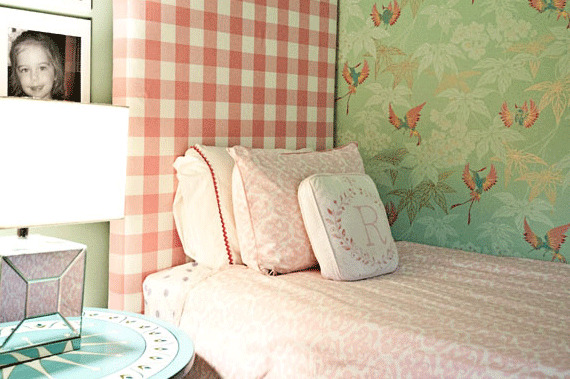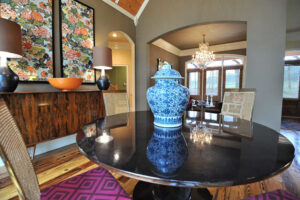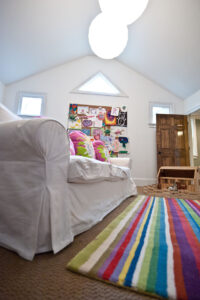


Punch it up with Pattern
Article by Johi Kokjohn-Wagner
Photography by Jennifer Little, Sugar Photography
Once you identify the ever-changing nature of personal taste and design, you can move forward with other selections, such as thoughtful color choices. Yet there is more to interior design than simply finding your style and color preferences. Another way to give your home an individual flair is through the use of the important design element of pattern.
Jade O’Connor, head designer of Jade O’Connor Designs in Georgia, lends her expertise to help simplify the integration of pattern into your home.
Several approaches can be used to add pattern in a space. The secret is staying true to your personal style and finding inspiration in prints and designs that speak to you. Whether you like minimal, understated graphics or a variety of bold forms, there is a pattern (or a variety of patterns) for every home. This is your opportunity to be adventurous and expressive, so don’t let the many selections available intimidate you.
“When designing homes, I find that people are afraid of pattern,” Jade said. “They use it as an accent in pillows or rugs. Maybe it comes from the 1960s and 1970s where color and pattern were everywhere and there was little balance and a lot of mixing bold with bold.”
 The most common uses of pattern are on upholstery, window treatments, wall coverings and rugs. Pattern can also be realized through non-traditional ways, such as an interesting collection of plates or treasured family heirlooms. Something as simple as a patterned lampshade or a printed table runner can add personality to a space. To help streamline the application of pattern into your home, Jade refers to four guidelines.
The most common uses of pattern are on upholstery, window treatments, wall coverings and rugs. Pattern can also be realized through non-traditional ways, such as an interesting collection of plates or treasured family heirlooms. Something as simple as a patterned lampshade or a printed table runner can add personality to a space. To help streamline the application of pattern into your home, Jade refers to four guidelines.
1. Repetition
In design of all types, one of the most successful ways to tie everything together is through repetition. Most good design always showcases repetition in some way, whether it be through color, form or texture. This theory also extends to pattern.
“If you love a pattern, there’s no reason not to use it everywhere,” Jade said. “Repeating the same print throughout a room on upholstery, walls and for window treatments can create a graphic haven. It takes a daring client to use a single print all over a room, but if done correctly, it’s a great look that really makes a gorgeous statement.”
2. Contrast
Whether mixing plaid with floral or stripes with print, contrasting patterns can blend beautifully and add a “homey” feel to a space.
 Be mindful to keep the scale contrasting, so as not to create visual
Be mindful to keep the scale contrasting, so as not to create visual
chaos. For example, if you find a pattern of small, striped lines you love, contrast it with a print of large shapes or flowers.
“When mixing patterns, I usually just pull together what I like and lay it out to see if it works, but there are a few general rules you can follow,” Jade said. “When mixing, all of the patterns you use should be of different scale. Too many small patterns can confuse the eye.”
3. Negative Space
To avoid cluttering a room with too much print, combine patterns with blocks of solid color. A printed couch atop a patterned rug, in front of printed curtains might be overwhelming. Balance and serenity in a space are as important as personalization.
 “Incorporate white to add negative space. White can add to the depth of a space,” Jade said. “If you’re not into white, allow areas of open-blocked color to give the eyes a rest.”
“Incorporate white to add negative space. White can add to the depth of a space,” Jade said. “If you’re not into white, allow areas of open-blocked color to give the eyes a rest.”
4. Complementary Colors
The tried and true color wheel will never fail in design. Complementary colors are across the wheel from each other: blue and orange, purple and yellow, red and green. These color marriages always make a statement and innately please the eye.
“Try to use colors that complement each other,” Jade said. “And when you lay it out, if it looks like it works together, it does. Trust your gut, go with your instincts.”
Embracing Pattern
“If you’re like me and you fall in love with fabrics, you’ll need to edit,” Jade advised. “Start with your colors, then add contrast. One big print, one medium and one small usually play well together. I don’t do matchy-matchy, but I do love a room that carries a pattern throughout. It has a finished, tailored look.
“Don’t forget about the walls. Wallpaper can add just the element of design you need to create a pulled-together space. Wallpaper is really back, and with all the different applications, like removable wallpaper, it’s not such a commitment anymore.”
Jade advises the layering of patterns with other elements, such as color, scale, shape and texture. Implementing pattern into your interior design will personalize and bring warmth to your space, thus making your home a welcoming environment for all who enter.
##
To learn more about standing out in your home décor, check out “Making a Statement” in the Summer 2014 issue of Chrome.
Related Reading
Part 1—Define, Design, Decorate
Part 2—A New Shade
SHARE THIS